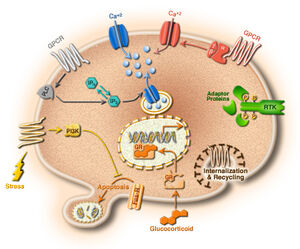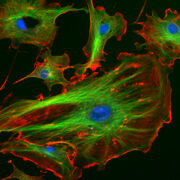Assessment |
Biopsychology |
Comparative |
Cognitive |
Developmental |
Language |
Individual differences |
Personality |
Philosophy |
Social |
Methods |
Statistics |
Clinical |
Educational |
Industrial |
Professional items |
World psychology |
Biological: Behavioural genetics · Evolutionary psychology · Neuroanatomy · Neurochemistry · Neuroendocrinology · Neuroscience · Psychoneuroimmunology · Physiological Psychology · Psychopharmacology (Index, Outline)
For the different types of cell see : Cell (biology)
Cell biology (also called cellular biology or formerly cytology, from the Greek kytos, "container") is an academic discipline that studies cells – their physiological properties, their structure, the organelles they contain, interactions with their environment, their life cycle, division and death. This is done both on a microscopic and molecular level. Cell biology research extends to both the great diversity of single-celled organisms like bacteria and the many specialized cells in multicellular organisms like humans.
Knowing the composition of cells and how cells work is fundamental to all of the biological sciences. Appreciating the similarities and also differences between cell types is particularly important to the fields of cell and molecular biology. These fundamental similarities and differences provide a unifying theme, allowing the principles learned from studying one cell type to be extrapolated and generalized to other cell types. Research in cell biology is closely related to genetics, biochemistry, molecular biology and developmental biology.

Understanding cells in terms of their molecular components.
Processes[]
Movement of proteins[]

Proteins (red and green stain) at different locations in a cell.
Each type of protein is usually sent to a particular part of the cell. An important part of cell biology is the investigation of molecular mechanisms by which proteins are moved to different places inside cells or secreted from cells.
Most proteins are synthesized by ribosomes in the cytoplasm. This process is also known as protein biosynthesis or simply protein translation. Some proteins, such as those to be incorporated in membranes membrane proteins, are transported into the ER or endoplasmic reticulum during synthesis and further processed in the Golgi apparatus. From the Golgi, membrane proteins can move to the plasma membrane, to other subcellular compartments or they can be secreted from the cell. The ER and Golgi can be thought of as the "membrane protein synthesis compartment" and the "membrane protein processing compartment", respectively. There is a semi-constant flux of proteins through these compartments. ER and Golgi-resident proteins associate with other proteins but remain in their respective compartments. Other proteins "flow" through the ER and Golgi to the plasma membrane. Motor proteins transport membrane protein-containing vesicles along cytoskeletal tracks to distant parts of cells such as axon terminals.
Some proteins that are made in the cytoplasm contain structural features that target them for transport into mitochondria or the nucleus. Some mitochondrial proteins are made inside mitochondria and are coded for by mitochondrial DNA. In plants, chloroplasts also make some cell proteins.
Extracellular and cell surface proteins destined to be degraded can move back into intracellular compartments upon being incorporated into endocytosed vesicles. Some of these vesicles fuse with lysosomes where the proteins are broken down to their individual amino acids. The degradation of some membrane proteins begins while still at the cell surface when they are cleaved by secretases. Proteins that function in the cytoplasm are often degraded by proteasomes.
Other cellular processes[]
- Cell division - The origin of new cells.
- Cell signaling - Regulation of cell behavior by signals from outside.
- Active transport and Passive transport - Movement of molecules into and out of cells.
- Adhesion - Holding together cells and tissues.
- Transcription and mRNA splicing - gene expression.
- Cell movement: Chemotaxis, Contraction, cilia and flagella
- DNA repair and Cell death
- Metabolism: Glycolysis, respiration, Photosynthesis
- Autophagy - The process whereby cells "eat" their own internal components or microbial invaders.
Internal cellular structures[]
Electronmicrograph.
- Organelle - term used for major subcellular structures
- Chloroplast - key organelle for photosynthesis
- Cilia - motile microtubule-containing structures of eukaryotes
- Cytoplasm - contents of the main fluid-filled space inside cells
- Cytoskeleton - protein filaments inside cells
- Ribosome - RNA and protein complex required for protein synthesis in cells
- Endoplasmic reticulum - major site of membrane protein synthesis
- Flagella - motile structures of bacteria, archaea and eukaryotes
- Golgi apparatus - site of protein glycosylation in the endomembrane system
- Membrane lipid and protein barrier
- Lipid bilayer - fundamental organizational structure of cell membranes
- Vesicle - small membrane-bounded spheres inside cells
- Mitochondrion - major energy-producing organelle
- Nucleus - holds most of the DNA of eukaryotic cells
Techniques used to study cells[]
- Microscopy and Immunostaining
- Gene knockdown and Transfection
- Cell culture and Radioactive tracers
- PCR and In situ hybridization
- DNA microarray screens of gene expression
- Computational genomics approaches are used to find patterns in genomic information [1]
Purification of cells and their parts
Purification may be performed using the following methods:
- Flow cytometry
- Cell fractionation
- Release of cellular organelles by disruption of cells.
- Separation of different organelles by centrifugation.
- Proteins extracted from cell membranes by detergents and salts or other kinds of chemicals.
- Immunoprecipitation.
See also[]
- Cell disruption
- Important publications in cell biology
- Institute of Molecular and Cell Biology
- The American Society for Cell Biology
Notable cell biologists[]
George Emil Palade
- Robert Hooke
- Anton van Leeuwenhoek
- Günter Blobel
- Marc Kirschner
- Peter Agre
- Keith R. Porter
- Ira Mellman
- Paul Nurse
- H. Robert Horvitz
- Christian de Duve
- Edmund Beecher Wilson
- Peter D. Mitchell
- Michael Swann
- George Emil Palade
- Geoffrey M. Cooper
References[]
- This article contains material from the Science Primer published by the NCBI, which, as a US government publication, is in the public domain at https://www.ncbi.nlm.nih.gov/home/about/policies/.
- ↑ Cristianini, N. and Hahn, M. Introduction to Computational Genomics, Cambridge University Press, 2006. (ISBN-13: 9780521671910 | ISBN-10: 0521671914)
External links[]
- American Society for Cell Biology
- British Society for Cell Biology
- Cells Alive
- BMC Cell Biology - online journal, open access
- Journal of Cell Biology - older issues free
- Journal of Cell Science - older issues free
- Cell Biology - School and University - graphics
- Nature Reviews Molecular Cell Biology (journal home)
- The Virtual Library of Biochemistry and Cell Biology
- Centre of the Cell online resource
- Springer Protocols for cell biology research
Online cell biology textbooks[]
- Molecular Biology of the Cell fourth edition, edited by Bruce Alberts (2002) published by Garland Science.
- Molecular Cell Biology fourth edition, edited by Harvey Lodish (2000) published by W. H. Freeman and Company.
- The Cell - A Molecular Approach second edition, by Geoffrey M. Cooper (2000) published by Sinauer Associates.
Major subfields of biology |
|---|
|
Anatomy - Astrobiology - Biochemistry - Bioinformatics - Botany - Cell biology - Ecology - Developmental biology - Evolutionary biology - Genetics - Genomics - Marine biology - Human biology - Microbiology - Molecular biology - Origin of life - Paleontology - Parasitology - Pathology - Physiology - Taxonomy - Zoology |
| This page uses Creative Commons Licensed content from Wikipedia (view authors). |
